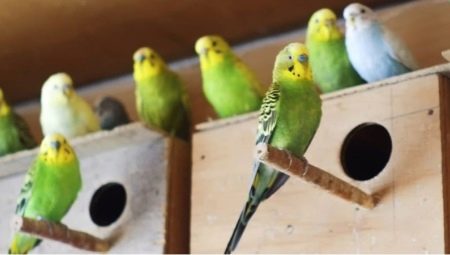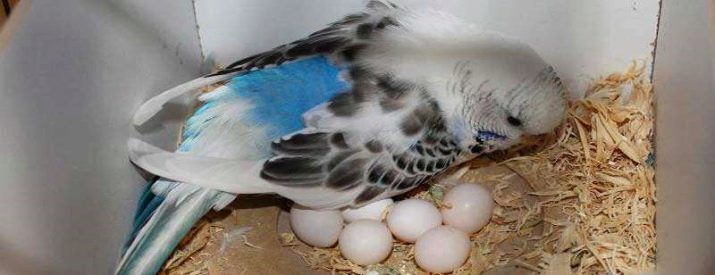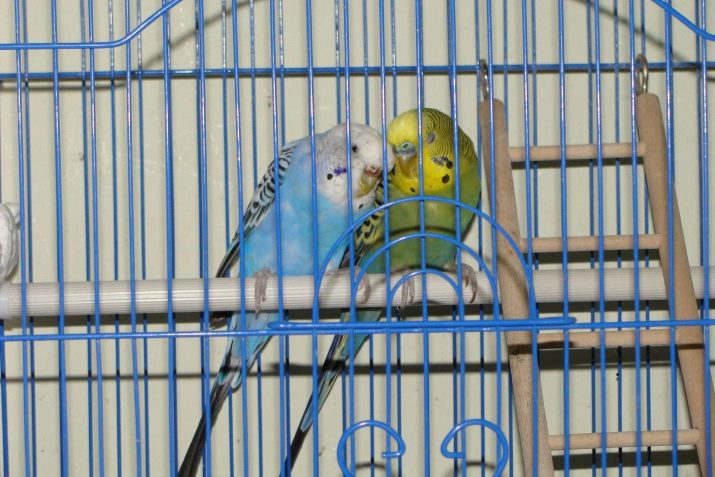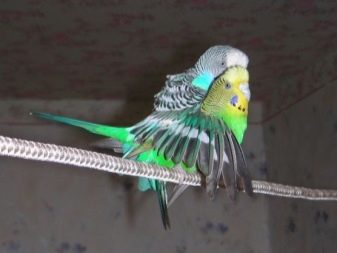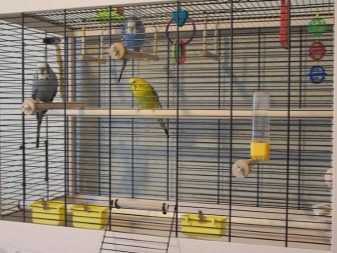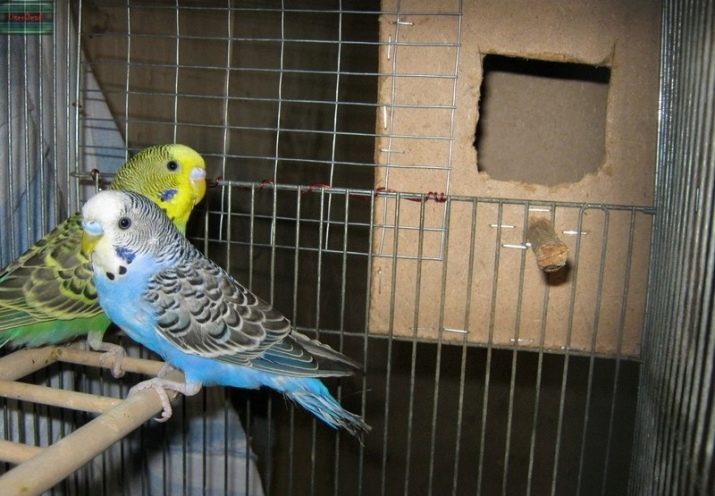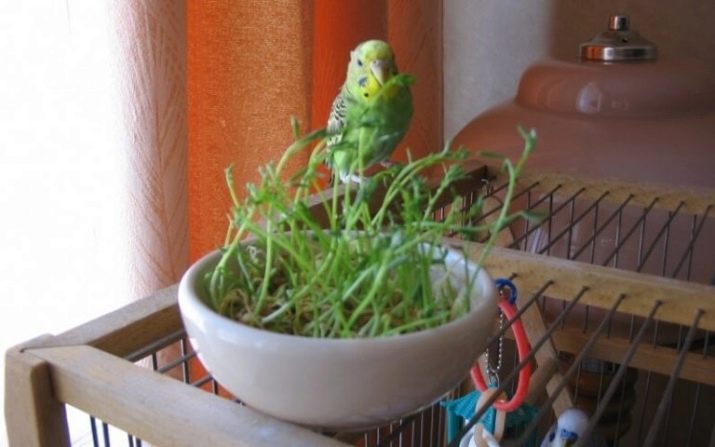Among feathery lovers, small budgerigars are deservedly popular. These birds own the honorary title of pets. This is not surprising - they are kind, affectionate and very entertaining creatures adoring their masters. Often breeders begin to breed their pets to increase their numbers. In this situation it will be useful to find out all the details of breeding birds.
Breeding characteristics
Wavy parrots are adapted for breeding in captivity, in addition, the birds are quite prolific, because they can breed up to 3 times a year. However, caring owners try to prevent such situations, otherwise the chicks may be born sick.
The best option is to lay eggs twice a year.
In order for the female to be able to produce offspring, the beginning poultry farmer must first of all understand that it is a schooling bird, therefore it needs a place for successful mating, as well as a partner. If several birds live in a cage at once, then it is impossible to determine in advance how they will choose a pair. The choice, as a rule, makes the parrot female. These families are very strong - the birds have not parted for quite a long time.
If you live only a male parrot, then you can buy a young female about 3-4 months old. It is no secret to anyone that usually female individuals dominate, so your parrot will have an excellent opportunity to tame the young bird "for yourself." As long as she grows up, she will have time to become strongly attached to her companion and will no longer show her sharp character.
If only a female of about one year old lives in your house, then it is best to purchase an adult male for her. Only he will be able to endure the explosive temperament and foul play of his girlfriend.
In any case, suitable for breeding exclusively adults, necessarily healthy and physically strong individuals, whose age has crossed a one-year boundary. It is best to take parrots from different nurseries, otherwise the risk of mixing related genes is great, which often leads to the birth of genetically mutated offspring.
The period of puberty in females begins after 12 months, and in males after 10 months. However, the most favorable age for productive breeding is considered to be 2-4 years of life, however, under favorable conditions in captivity, birds can successfully lay eggs up to 8-10 years, in some cases even longer.
For domestic birds, the first mating is best done at the age of 14 months.
The best period for mating
The best time for successful mating is the warm season - from the second decade of May to early September. During this period, the birds have enough light, green succulent feed and temperature background. In the spring, the feathered organism experiences a strong avitaminosis, becomes weakened, and the female is unable to bear strong offspring. The offspring conceived at such a time is in most cases underdeveloped and dies even in the egg.
Birds have every chance to fully reproduce in captivity, subject to several basic rules:
- the presence of a spacious enclosure with a nest for chicks;
- long daylight hours - up to 15-16 hours (if necessary artificially prolonged);
- air temperature - at least 22 degrees;
- nutrition with the inclusion of juicy herbs at least 2 times a day;
- maintaining the hygiene of the home.
Keep in mind that these rules only work if the birds have reached their sexual maturity.
If the female is still too young or, on the contrary, is already elderly, it is not worth artificially creating conditions favorable for mating. It should be noted that The marriage games of budgerigars are an extremely touching sight. During this period, the male begins to very gently care for the female, in every possible way pleases her, adopts the most amusing postures only so that his beloved pay attention to him.
At these moments, loud singing is heard, in addition, the male of parrots begins to flow - to peck with a beak in a wide variety of subjects, including the beak of his female. The seriousness of the intentions of the male can be understood by his desire to feed the female. If breeders began to notice that the male begins to constantly offer his beloved tidbits, therefore, his behavior signals the readiness to take care of her and their future offspring, because it will be the male who will be responsible for food extraction at a time when the female starts laying and hatching eggs.
It is best to set a young couple in a separate cage and follow their further relationship. - if they do not begin to peck at each other and pull the feathers, then we can count on the imminent appearance of chicks.
Budgerigars - Monogamous. If they reciprocate on the care of another bird, then attachment will remain between them for the rest of their lives. It will not be possible to force the birds to breed forcibly - the chicks only appear “for love”.
Birds mate pretty quickly, so that some owners do not even have time to notice this. Usually the female unfolds almost to a horizontal position, the partner sits on top and very quickly fertilizes her, acquiring wings. Depending on the physiological characteristics of the birds, fertilization can be successful already after the very first intercourse, and can take several weeks.
In order to make the process more successful, you can resort to a little trick - a couple of weeks before the act, the birds should be allowed to fly as much as possible: during such flights, their muscles become stronger, their appetite increases and their metabolism is normalized.
If the birds have reached their goal from the first, the parrots will still continue to mate for several more days. It is usually possible to determine if the attempt was successful, after several days the bird begins to engage in "nesting". At this point, care should be taken to install the nest inside the cage, as well as to provide the feathered materials that they may need to arrange the future incubator.
At first, parrots may not perceive the house, but usually this phenomenon is only temporary: after a couple of days, the female will begin to explore the nest from all sides and restore “nest” in it at its discretion. At this point, the male parrot continues to care for the future mother, takes care of her feeding and happily tweets at the same time.
How to keep?
The minimum size of a cage for one pair of birds is 60x40x40 cm. If a cage contains two pairs at once, then the size of the dwelling should be larger. Optimally, the bottom of the aviary could be extended, and the side bars provided the opportunity to attach a nest to them.
On sale you can find nests from a variety of materials, but most often they are made of plastic and wood. The first is cheaper, but at the same time impractical, short-lived and uncomfortable. Wooden ones are much more suited to the needs of young parents and chicks - they give a good heat exchange and have a pleasant texture for birds.
Depending on the design features can be set ready nests of three kinds.
- Horizontal - they are very convenient for entry of females, and the clutch remains intact and intact at the moment of incubation. However, too low an inlet may provoke young birds to leave the nest too early, which often leads to their injuries.
- Vertical - in this case, the manhole is quite high and the chicks can remain in their cozy nest until the final formation, but this creates the risk that the female can crack eggs at the entrance.
- Compression - Perhaps the best option for feathered birds. The structure of such a nest is convenient for both young parents and their young, with the additional step allowing to keep the clutch intact and safe.
Skilled craftsmen, if desired, can make a nest with their own hands.
It is necessary to prepare for the reproduction of birds in advance. For example, increase the length of daylight should be gradually. If this is done abruptly, then molting may begin in birds, and such birds should not be allowed to mate.
The hygiene of the home of a pregnant parrot is very important.. All surrounding objects with which the expectant mother may be in contact must be disinfected. To do this, the cage itself, as well as all drinkers, feeders and favorite toys are washed with water with the addition of a small amount of bleach with a brush, and then rinsed thoroughly.
The house for further nesting is washed with antibacterial soap, dried and calcined for about half an hour in an oven or microwave. If the nest is made of plastic, then it can be held in the open sun for at least 6 hours. In sawdust scattered along the bottom, you should add the herb pharmacy chamomile - this will prevent an invasion of ticks and other dangerous insect parasites. It is desirable to place the cell in a quiet place, preferably secluded. For the period of mating parrots all extraneous noise should be minimized.
What to feed?
Nutrition of the future mother should be complete and varied throughout the period while she is carrying eggs. In addition to the grain mixture, it should consume cereals, fruits, vegetables, juicy greens and young shoots of fruit trees. It is extremely important in such a period mineral supplements, as well as cottage cheese and eggs - they serve as a source of readily absorbable calcium.
At the time of nesting female need enhanced nutrition. Breeding of birds, whose diet consists only of grain and apples with carrots, is strictly not allowed. It is important that the bird receives all the types of feed listed. During this period, the presence in the menu of sources of vitamin E, which promotes reproduction is very important. You can buy it at any veterinary pharmacy.
Sprouted grains of oats, wheat and other cereals are quite useful.
It is imperative to ensure the parrot access to drinking water. It is advisable to give the bird bottled or filtered. Do not forget to wash the drinker regularly, and immediately throw away all uneaten fruits, berries and vegetables.
Good feed mixtures at the breeding stage are:
- carrots + juicy grass + buckwheat porridge + boiled egg;
- sprouted grass + chopped beets + hard-boiled egg;
- germinated grass + Bulgarian pepper + gammarus;
- hot water steamed cereal + juicy grass + sprouted legumes + cauliflower;
- friable cottage cheese + ground pumpkin + young greens + sprouted oats.
In the aviary must certainly be placed sepia - mineral stone. It is a good source of calcium.
If the female does not show any interest to him, it makes sense to add powdered calcium gluconate tablets to food - this will allow the shell to be more durable, and the embryos themselves to develop successfully. As soon as the female lays eggs, Try to increase the degree of air humidity near the nest to 60-65%, otherwise the film will entangle the chick and he will simply suffocate. Usually, humidifiers are used or room fountains are placed near the cell.
After laying eggs soft foods should be immediately eliminated from the diet of the femaleand the volume of grain, on the contrary, doubled. Chicken eggs at this time give very rarely and in scanty volumes. Two to three days before hatching of chicks, chicken eggs can be returned to the mother’s diet, and Strengthen the menu with carotene-rich foods such as carrots, beets, and bell peppers.
How many days do eggs hatch?
Usually, the female can carry eggs at intervals of 1-2 days. The total number of eggs is influenced by the age of feathered pets. Usually there are 4-7 eggs, although the best option is considered to be 5 - only this amount can heat the bird evenly. If there are more eggs, you should either put part of them to another pair, or use a special incubator.
Usually chicks hatch after 18-19 days. Birds from the inside break the shell with their beak, and if they cannot do this themselves, their mother helps them. After the birth of the first child his mother’s consumption of germinated seeds should be reduced, replacing them with vegetables.
It happens that the chicks do not appear from all the eggs, some remain frozen.
It is usually considered the norm when their number is 1-2, such situations occur if the female is very young and has not managed to warm the clutch fully. If not a single chick has hatched from the eggs, most likely one of the following causes occurs:
- infectious and fungal diseases of parents;
- insufficient moisture level near the nest;
- excessively cool indoor air;
- lack of hygiene of the dwelling in which the birds are sitting;
- poor-quality food or violation of the drinking regime;
- genetic incompatibility of the pair.
The chicks during this period are very weak, after they are born, they cannot even hold their heads on their own, therefore they lie on their backs. At this stage, the mother takes over all the care for their sustenance: she feeds them with goiter mucous secretions with the addition of undigested food pieces.
Usually, the breeder is only required to closely monitor the development of events in the nest, the active participation of the person is necessary only if for some reason the female and male cannot or do not want to feed the newborn naturally. Then you have to feed them artificially.
On the subtleties of reproduction of wavy parrots at home, see below.
